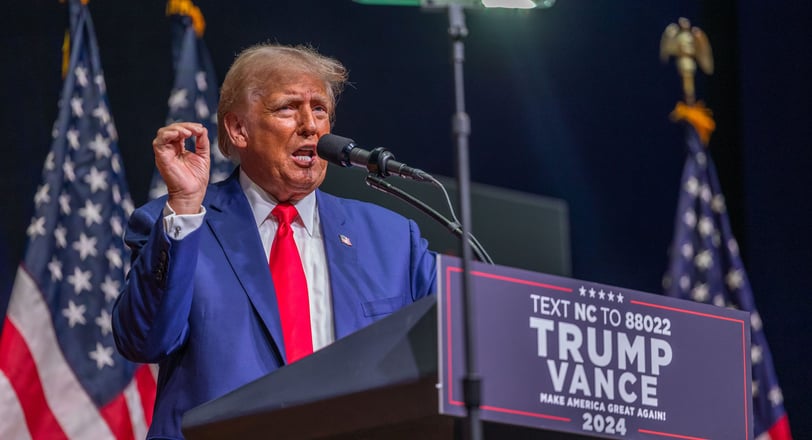Add your promotional text...
Tariffs, Trade Wars, and Tough Talk: Analyzing President-Elect Trump's Bold Economic Stance
Synopsis: President-elect Donald Trump has announced sweeping tariff plans targeting China, Mexico, and Canada, aimed at curbing drug flow and illegal immigration. This blog unpacks the implications of these proposals, their potential economic impacts, and the risks of reigniting global trade wars.
MARKETSGLOBAL
By Alankrita Shukla
11/26/20243 min read


As President-elect Donald Trump prepares to take office, his administration's proposed economic policies are once again making headlines. Among the most contentious announcements are new tariffs aimed at addressing two of Trump's key concerns: the influx of illegal drugs and immigration. These tariffs, if enacted, could escalate tensions with major trading partners and reshape the global trade landscape.
The China Tariff: Fighting Drugs or Fueling Conflict?
In a post on Truth.Social, Trump declared his intent to impose an additional 10% tariff on all Chinese imports. This measure is intended to pressure Beijing into taking more significant steps to stem the flow of illegal drugs, particularly fentanyl, into the United States.
Trump emphasized that discussions with Chinese officials had failed to produce meaningful outcomes, claiming that drug inflows into the U.S., especially through Mexico, had reached unprecedented levels. He stated, “Until such time as they stop, we will be charging China an additional 10% Tariff, above any additional Tariffs, on all of their many products coming into the United States of America.”
This proposed tariff follows earlier threats of imposing up to a 60% tariff on Chinese goods—a move that could trigger a renewed trade war between the world’s two largest economies. While the aim is to address drug trafficking, critics argue that such tariffs could have unintended economic consequences, including higher consumer prices and strained diplomatic relations.
North America in the Crosshairs: Tariffs on Mexico and Canada
Trump's tough stance extends beyond China. In another announcement, he proposed a 25% tariff on all imports from Mexico and Canada. These tariffs, he claimed, would address concerns over illegal immigration and drug trafficking across the U.S.’s northern and southern borders.
In his statement, Trump vowed to implement these tariffs as part of his first executive orders upon taking office on January 20. He warned that these tariffs would remain in effect until drug trafficking and illegal immigration were significantly curtailed.
Trump said, “Both Mexico and Canada have the absolute right and power to easily solve this long-simmering problem.”
These announcements mark a continuation of Trump’s protectionist trade policies, echoing his rhetoric from his first term, during which the U.S. imposed significant tariffs on several trading partners.
The Risks of Renewed Trade Wars
Trump’s proposed tariffs risk reigniting trade tensions that characterized much of his first term. The potential for a new wave of trade wars could have far-reaching consequences:
Economic Disruptions: Additional tariffs on Chinese goods could increase costs for U.S. businesses and consumers, potentially slowing economic growth. Tariffs on North American imports may disrupt supply chains critical to industries like automotive manufacturing and agriculture.
Global Repercussions: Major trading partners could retaliate with tariffs on U.S. goods, exacerbating global economic uncertainty and reducing international trade volumes.
Diplomatic Strains: These unilateral actions could erode trust with key allies and trading partners, complicating future negotiations on broader economic and security issues.
Policy Goals vs. Practical Challenges
While Trump’s tariff proposals are rooted in addressing serious issues—drug trafficking and illegal immigration—the effectiveness of these measures remains uncertain. Critics point out several challenges:
Limited Influence on Drug Trafficking: Tariffs on Chinese goods may not directly influence drug trafficking dynamics, particularly when many illegal drugs enter the U.S. through clandestine routes.
Impact on Immigration Policy: Immigration is a complex issue involving legal, social, and economic factors. Tariffs alone may not achieve the desired outcomes.
Economic Blowback: Higher tariffs could backfire by increasing costs for American consumers and businesses, undermining the very economy these policies aim to protect.
What Lies Ahead?
As the U.S. prepares for a new administration, Trump’s proposed tariffs highlight his commitment to protectionist policies and hardline economic measures. However, these actions carry significant risks, including potential trade conflicts, economic slowdowns, and geopolitical tensions.
The impact of these tariffs will ultimately depend on how they are implemented and the responses of trading partners like China, Mexico, and Canada. While the rhetoric is bold, the practicalities of enacting and sustaining such policies remain a significant hurdle.
Conclusion: The Stakes Are High
President-elect Trump’s proposed tariffs are a bold statement of intent, signaling a return to the protectionist trade policies of his earlier tenure. While aimed at addressing critical issues like drug trafficking and immigration, the broader implications of these measures could reshape the global economic landscape. As the world watches closely, the question remains: will these policies achieve their intended goals, or will they ignite new challenges in an already volatile economic environment?
For businesses, policymakers, and investors, the months ahead will require careful navigation of these complex dynamics.
